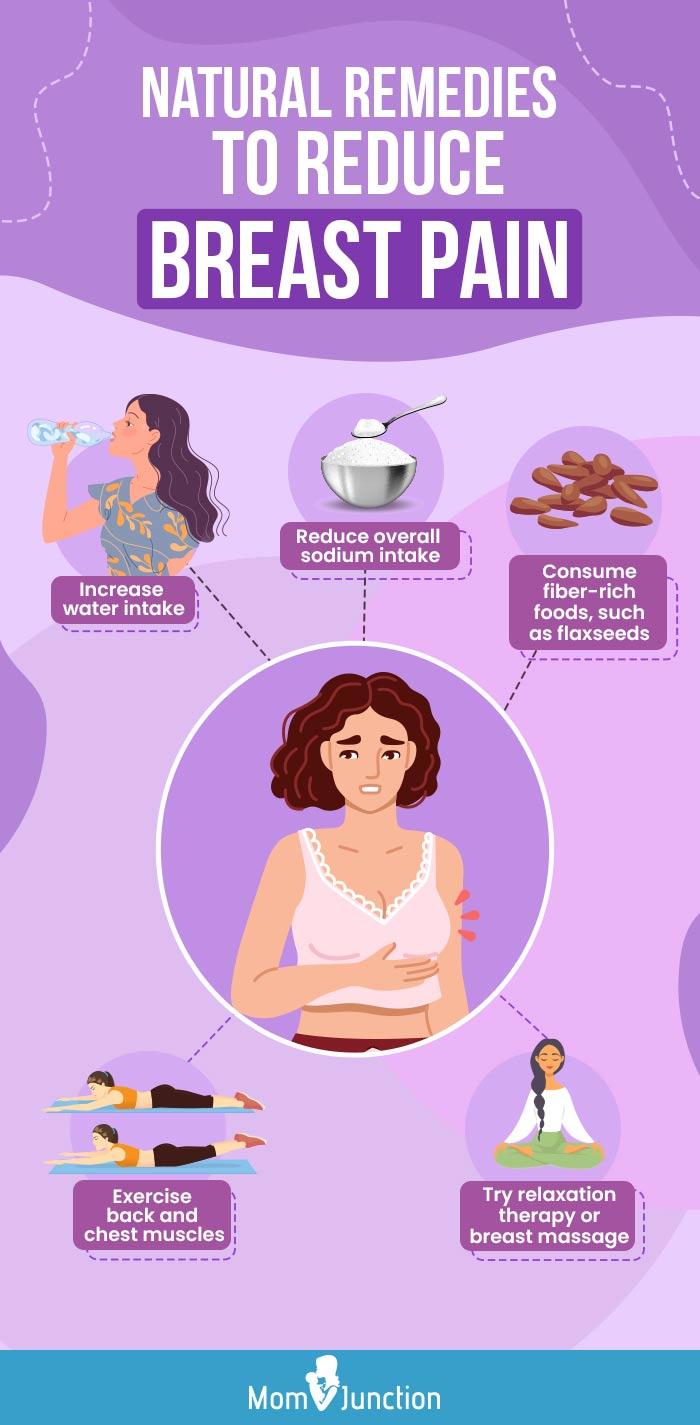Breast pain localized in the glandular breast tissue and similar to premenstrual soreness indicates early pregnancy. Experiencing breast pain can be one of the initial signs of pregnancy.
While PMS may also cause breast tenderness, early pregnancy may involve an overall sensation of breast tenderness, appearing around one to two weeks after conception. This tenderness can be similar to the soreness experienced before getting your period. Additionally, early pregnancy may cause nipples to become larger and the areolas to appear darker.
Understanding the differences between PMS and pregnancy symptoms can help in identifying the cause of breast pain. Monitoring other symptoms such as fatigue and the absence of menstruation may also provide clues to potential pregnancy.

Credit: www.momjunction.com
Understanding Breast Pain In Pregnancy
Experiencing breast pain is a common occurrence during pregnancy. As the body undergoes various hormonal changes, the breasts can become tender, sore, and even swollen. Understanding the signs and symptoms, duration and timing, as well as the causes of breast pain during pregnancy, can help expectant mothers better navigate this uncomfortable but temporary part of their pregnancy journey.
Signs And Symptoms
During pregnancy, breast pain can manifest in different ways. The breasts may feel tender to the touch, causing discomfort when touched or when wearing a bra. Some women also experience a general soreness or heaviness in the breasts. Additionally, changes in nipple sensitivity, such as increased sensitivity or tingling sensations, may occur. Another noticeable sign is the darkening and enlargement of the areolas, the area surrounding the nipples. Overall, these signs and symptoms are often one of the earliest indicators of pregnancy.
Duration And Timing
The duration and timing of breast pain during pregnancy vary from woman to woman. Generally, breast pain can start as early as one to two weeks after conception and can last throughout the first trimester. However, some women may continue to experience breast pain throughout their pregnancy, while others may find that it subsides after the first few weeks. It is important to keep in mind that every pregnancy is different, and the intensity and duration of breast pain can vary.
Causes Of Breast Pain
The primary cause of breast pain during pregnancy is the hormonal changes that are happening in the body. In particular, the increased levels of hormones like estrogen and progesterone can lead to breast tenderness and sensitivity. These hormones can cause the milk ducts and glands in the breasts to enlarge, preparing them for milk production. Additionally, increased blood flow to the breasts can contribute to the swelling and discomfort. It is important to note that breast pain during pregnancy is typically not a cause for concern unless accompanied by other severe symptoms.
Other Breast Changes
Alongside breast pain, there are other notable changes that occur in the breasts during pregnancy. As mentioned earlier, the size and color of the areolas may change, becoming larger and darker. The nipples themselves may also become larger and more sensitive. Some women may notice the appearance of small bumps on the areolas, known as Montgomery's tubercles, which secrete oils to keep the nipples lubricated. These changes are all normal and result from the preparation of the breasts for breastfeeding.
Differentiating Between Pregnancy And Period Breast Pain
Breast pain is a common concern among women, and it can be challenging to differentiate between pain experienced during pregnancy and menstrual cycle-related pain. Understanding the key differences in symptoms associated with breast pain during PMS and pregnancy can provide valuable insights for women trying to conceive. Let's delve into this topic by exploring the distinct characteristics of breast pain during these two phases.
Breast Pain During Pms
During the premenstrual phase, many women experience breast tenderness and swelling. This discomfort is primarily attributed to hormonal fluctuations, specifically elevated levels of estrogen and progesterone. These hormonal shifts can lead to increased sensitivity and discomfort in the breast tissue. However, it's crucial to note that this type of breast pain typically resolves shortly after the onset of menstruation.
Key Differences
- Frequency: Breast pain associated with pregnancy tends to persist, often intensifying with time, whereas PMS-related breast discomfort typically subsides with the onset of the menstrual period.
- Accompanying Symptoms: Women experiencing breast pain in the early stages of pregnancy may also notice other indications, such as fatigue, darkening and enlargement of the areolas, and a generalized feeling of tenderness in the breast tissue, which may not be present during PMS.
- Duration: Unlike period-related breast pain, which is generally short-lived, discomfort stemming from pregnancy can continue throughout the first trimester and beyond.
Identifying Pregnancy Breast Pain
For women who suspect they may be pregnant, it's essential to be aware of certain manifestations that differentiate pregnancy-related breast pain from discomfort linked to the menstrual cycle. It's crucial to keep in mind that the absence of menstruation, coupled with persistent breast tenderness and accompanying symptoms, may indicate a potential pregnancy. Seeking guidance from a healthcare professional and conducting a pregnancy test can provide clarity and peace of mind.
Physical Changes In The Breasts During Early Pregnancy
During early pregnancy, the body undergoes several changes to accommodate the growing fetus. Among these changes, physical alterations in the breasts are prominent indicators of pregnancy. Understanding the physical changes in the breasts during early pregnancy can help individuals recognize the signs and prepare for the journey ahead.
Enlargement Of Areolas
One of the noticeable changes that typically occur in the breasts during early pregnancy is the enlargement of areolas. The areolas, the pigmented areas around the nipples, may increase in size and become darker. This change is attributed to hormonal fluctuations in the body, preparing the breasts for the upcoming breastfeeding process.
Increased Sensitivity
Another significant indication of early pregnancy is the increased sensitivity of the breasts. Women may experience heightened tenderness and sensitivity in their breast tissue, especially around the nipples. This can often be uncomfortable but is a common and normal occurrence during the first trimester of pregnancy.
Tingling Sensation
A tingling sensation in the breasts is also a common early sign of pregnancy. This sensation is often described as a mild, tingling feeling in the breast tissue, and it is related to the increased blood flow and hormonal changes that support the development of the mammary glands.

Credit: www.bannerhealth.com
Managing Breast Tenderness In Pregnancy
Breast pain during early pregnancy is not localized and occurs in the glandular breast tissue, similar to premenstrual soreness. It is important to note that pregnancy does not coincide with a period.
If you are experiencing breast tenderness during pregnancy, you're not alone. Many women experience this discomfort as their bodies go through hormonal changes. While breast pain can be a common symptom during this time, it can still be managed and relieved. Here are some ways to alleviate breast tenderness:
Supportive Bras
Investing in supportive bras can make a world of difference when it comes to managing breast tenderness during pregnancy. These bras provide extra support, reducing the strain on your breasts and minimizing discomfort. Look for bras with wider straps and adjustable closures for a customized fit. Additionally, opting for bras made from soft, breathable fabrics can help prevent irritation.
Warm Compresses
Another effective way to manage breast tenderness is by using warm compresses. Applying a warm compress to your breasts can help alleviate soreness and promote relaxation. You can either use a warm towel or purchase specially designed gel packs that can be heated. Simply place the warm compress on your breasts for a few minutes several times a day to experience relief.
Gentle Massages
Gentle massages can be soothing and beneficial for managing breast tenderness. Using your fingertips, apply gentle pressure in circular motions on your breasts. This can help improve blood circulation and reduce discomfort. Remember to be cautious and avoid applying excessive pressure, as this can worsen the pain.
Proper Hydration
Staying properly hydrated during pregnancy is essential for overall well-being and can also help manage breast tenderness. Drinking an adequate amount of water can help regulate hormonal levels and prevent water retention, which can contribute to breast pain. Aim to drink at least eight glasses of water per day to stay hydrated and minimize discomfort.
Managing breast tenderness during pregnancy is all about finding what works best for you. Remember to listen to your body and prioritize self-care. If the pain becomes severe or persists, consult with your healthcare provider for further guidance. By implementing these strategies, you can alleviate breast tenderness and focus on enjoying this special time of pregnancy.
When To Seek Medical Advice
If you experience breast pain during pregnancy, it's important to know when to seek medical advice. While some degree of breast pain and discomfort is normal during pregnancy, there are certain situations where it may indicate a more serious issue. Keep an eye out for the following signs and symptoms:
Severe Pain Or Swelling
If you are experiencing severe breast pain or swelling that is not relieved by over-the-counter remedies, it is essential to consult your healthcare provider. This could be a sign of a more serious condition such as mastitis or a clogged milk duct. Prompt medical attention can help alleviate the pain and prevent any complications.
Nipple Discharge
If you notice any unusual discharge from your nipples during pregnancy, it is important to seek medical advice. While some nipple discharge can be normal, particularly in the later stages of pregnancy, any discharge that is bloody or pus-like should be evaluated by a healthcare professional. This could be indicative of an infection or other underlying issue that requires treatment.
Lumps Or Abnormalities
If you discover any lumps, bumps, or abnormalities in your breasts during pregnancy, it is crucial to have them evaluated by a healthcare provider. While most breast changes during pregnancy are normal, any new or unusual lumps should be thoroughly examined. Your healthcare provider can perform a clinical breast exam and, if necessary, order further diagnostic tests to ensure the health and well-being of both you and your baby.
Remember, it's always better to be safe than sorry when it comes to your health and the health of your baby. If you experience any concerning or unusual breast pain, swelling, nipple discharge, or lumps during pregnancy, don't hesitate to seek medical advice. Your healthcare provider can provide the necessary care and guidance to ensure a healthy and happy pregnancy.
:max_bytes(150000):strip_icc()/VWH-JakeShi-PotentialReasonsforExperiencingBreastPain-Standard-c73f2202af3146309c0726248ffba38d.jpg)
Credit: www.verywellhealth.com
Frequently Asked Questions Of What Kind Of Breast Pain Indicates Pregnancy
What Part Of The Breast Hurts In Early Pregnancy?
During early pregnancy, breast pain isn't localized and occurs in the glandular breast tissue. It may feel similar to the soreness before your period, resulting in an overall sensation of tenderness. The areolas may also appear darker and larger.
How Do You Know If Breast Pain Is Pregnancy Or Period?
Breast pain during early pregnancy may feel similar to soreness before your period. However, the discomfort is not localized but occurs throughout the glandular breast tissue. In pregnancy, breast tenderness is accompanied by fatigue, unlike in premenstrual syndrome (PMS).
How Many Days Before Pregnancy Do Your Breasts Hurt?
Breast pain can occur one to two weeks after conception, indicating early pregnancy or period. The pain is felt in the glandular breast tissue and might feel similar to premenstrual soreness. It may include an overall sensation of breast tenderness.
Conclusion
Breast pain during pregnancy is a common symptom caused by hormonal changes and increased blood flow to the breasts. It is usually not localized but felt as an overall tenderness in the glandular breast tissue. While breast pain can also occur during PMS, a key difference is the absence of a period.
Other changes such as darkening and enlargement of the areolas may also be observed. If you're experiencing breast pain and other pregnancy symptoms, it's advisable to take a pregnancy test or consult with a healthcare professional for confirmation.






0 Comments